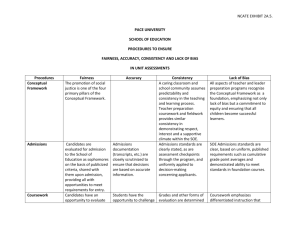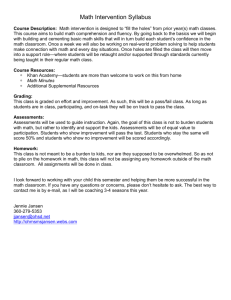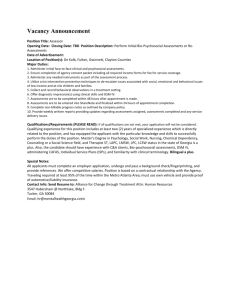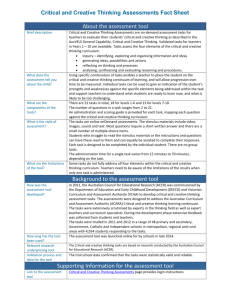Fairness, Accuracy, Consistency, and the Elimination of Bias
advertisement
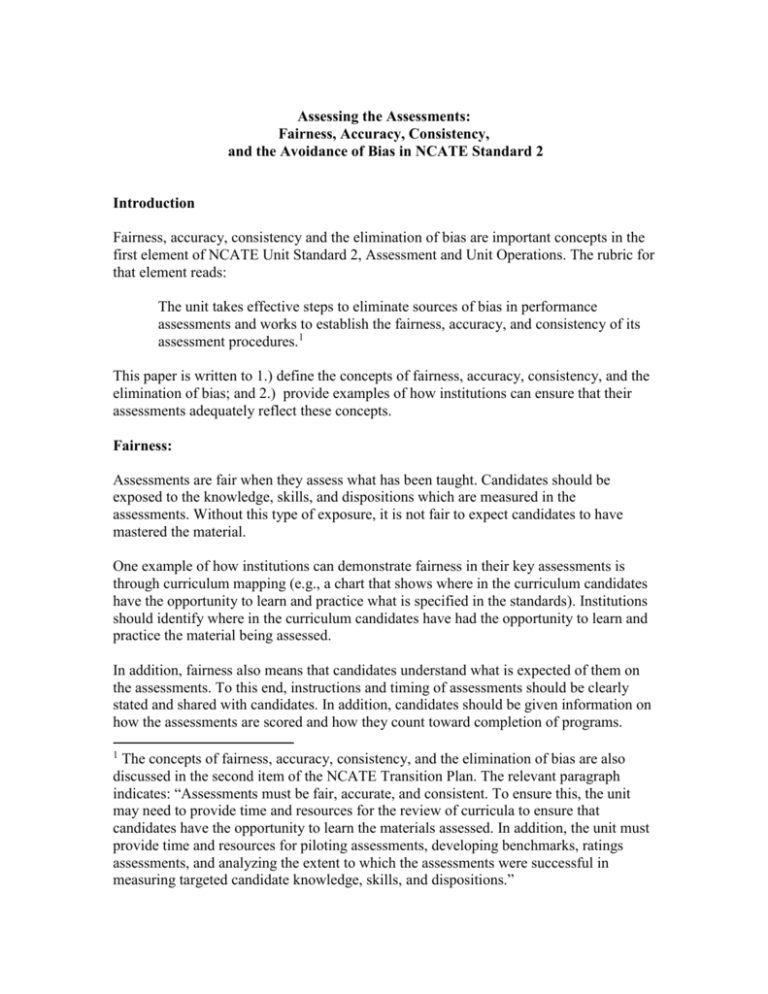
Assessing the Assessments: Fairness, Accuracy, Consistency, and the Avoidance of Bias in NCATE Standard 2 Introduction Fairness, accuracy, consistency and the elimination of bias are important concepts in the first element of NCATE Unit Standard 2, Assessment and Unit Operations. The rubric for that element reads: The unit takes effective steps to eliminate sources of bias in performance assessments and works to establish the fairness, accuracy, and consistency of its assessment procedures.1 This paper is written to 1.) define the concepts of fairness, accuracy, consistency, and the elimination of bias; and 2.) provide examples of how institutions can ensure that their assessments adequately reflect these concepts. Fairness: Assessments are fair when they assess what has been taught. Candidates should be exposed to the knowledge, skills, and dispositions which are measured in the assessments. Without this type of exposure, it is not fair to expect candidates to have mastered the material. One example of how institutions can demonstrate fairness in their key assessments is through curriculum mapping (e.g., a chart that shows where in the curriculum candidates have the opportunity to learn and practice what is specified in the standards). Institutions should identify where in the curriculum candidates have had the opportunity to learn and practice the material being assessed. In addition, fairness also means that candidates understand what is expected of them on the assessments. To this end, instructions and timing of assessments should be clearly stated and shared with candidates. In addition, candidates should be given information on how the assessments are scored and how they count toward completion of programs. 1 The concepts of fairness, accuracy, consistency, and the elimination of bias are also discussed in the second item of the NCATE Transition Plan. The relevant paragraph indicates: “Assessments must be fair, accurate, and consistent. To ensure this, the unit may need to provide time and resources for the review of curricula to ensure that candidates have the opportunity to learn the materials assessed. In addition, the unit must provide time and resources for piloting assessments, developing benchmarks, ratings assessments, and analyzing the extent to which the assessments were successful in measuring targeted candidate knowledge, skills, and dispositions.” Accuracy: Assessments are accurate when they measure what they purport to measure. To this end, the assessments should be aligned with the standards and/or learning proficiencies that they are designed to measure. Three characteristics that determine alignment of assessments with standards are: (a) the same or consistent categories of content appear in the assessments that are in the standards; (b) the assessments are congruent with the complexity, cognitive demands, and skill requirements described in the standards; and (c) the level of effort required, or the degree of difficulty is consistent with standards and reasonable for candidates who are ready to teach or take on other professional responsibilities. The assessments should be aligned with the knowledge, skills, and dispositions being assessed. For example, a pencil-and-paper test is not an appropriate assessment of classroom skills, but may be an efficient way to document candidate knowledge of different instructional approaches and when to use them. A classroom observation may not be the best way to assess a candidate’s content knowledge,2 but may with structured scoring guides be a useful way to evaluate candidates’ dispositions. Accuracy is closely related to the statistical term “validity.” However, establishing validity requires statistical analysis beyond what is called for in the NCATE standards. Most institutions already employ several activities that ensure accuracy of assessments.3 One activity is simply reviewing assessments to ensure alignment and appropriateness, and documenting the review. This can happen once a year at a staff meeting, or in programmatic committees, or could be done by one person and discussed with a larger group. Accuracy can also be supported by documenting the relationship between assessment results and candidate performance on related assessments, grades, and program completion. Consistency: Assessments are consistent when they produce dependable results or results that would remain constant on repeated trials. Essentially, in approaching consistency, the standards are requiring that the assessments and results be trustworthy. In other words, if the same 2 For further information on the appropriateness of assessments, see www.ncate.org/institutions/article_commission.asp?ch=87 and choose “Commissioned papers on Development of Assessment Systems and Aggregating Data,” then select Stiggins, Specifications for a Performance-based Assessment System for Teacher Preparation 3 For further information on reviewing the accuracy of assessments, see http://www.ncate.org/resources/assessment/assessment_examples.pdf information were assessed on different occasions, with no intervention, and the results were largely the same, then the assessment could be said to be consistent. Consistency is closely related to the statistical term “reliability.” However, NCATE consciously chose not to use the term “reliability” because the concept can be adequately addressed with methods that can be inclusive of, but also other than statistical analysis. Institutions can document consistency through providing training for raters that promote similar scoring patterns, using multiple raters, conducting simple studies of inter-rater reliability, and/or by comparing results to other internal or to external assessments that measure comparable knowledge, skills and/or dispositions. Avoidance and Elimination Bias Closely related to accuracy is the elimination of bias. To ensure that the results of assessments adequately reflect what candidates know and can do, it is important to remove any contextual distractions and/or problems with the assessment instruments that introduce sources of bias and thus adversely influence candidate performance. Contextual distractions include inappropriate noise, poor lighting, discomfort, and the lack of proper equipment. Problems with assessments include missing or vague instructions, poorly worded questions, and poorly reproduced copies that make reading difficult.4 The elimination of bias also means that the assessments are free of racial and ethnic stereotypes, poorly conceived language and task situations, and other forms of cultural insensitivity that might interfere with candidate performance and unintentionally favor some candidates over others. Further, the elimination of bias includes consistent scoring of assessments and vigilant efforts not to discriminate against groups of candidates. Ultimately, it is important that units evaluate assessments and assessment conditions and eliminate as many sources of bias as possible. While the standards use the term “eliminate,” in fact, it is best to avoid sources of bias as the assessments are being developed. NCATE believes that institutions must address these issues of fairness, accuracy, consistency and the avoidance/elimination of bias as an integral component of the development and implementation of a high quality assessment system. If institutions do not adequately address these issues, then the quality of the assessment system can be legitimately questioned, and the data derived from the assessments may not sufficiently address the elements in Standard 1. 4 For a list of additional sources of bias, see www.ncate.org/institutions/article_commission.asp?ch=87 and choose “Commissioned papers on Development of Assessment Systems and Aggregating Data,” then select Stiggins, Specifications for a Performance-based Assessment System for Teacher Preparation, p.9,13.


